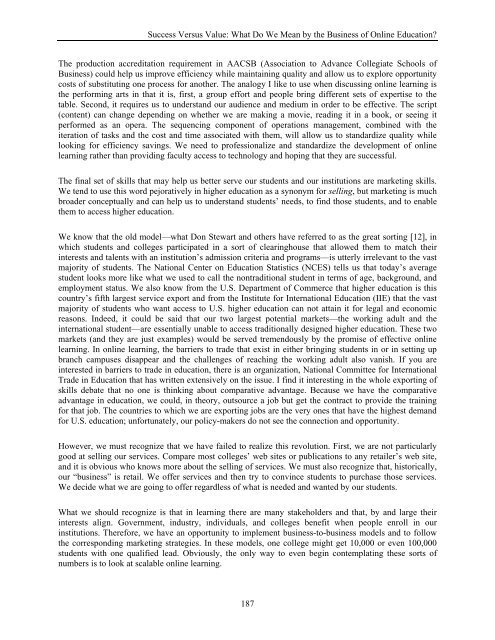Elements of Quality Online Education cation
Elements of Quality Online Education cation
Elements of Quality Online Education cation
You also want an ePaper? Increase the reach of your titles
YUMPU automatically turns print PDFs into web optimized ePapers that Google loves.
Success Versus Value: What Do We Mean by the Business <strong>of</strong> <strong>Online</strong> <strong>Edu<strong>cation</strong></strong>?The production accreditation requirement in AACSB (Association to Advance Collegiate Schools <strong>of</strong>Business) could help us improve efficiency while maintaining quality and allow us to explore opportunitycosts <strong>of</strong> substituting one process for another. The analogy I like to use when discussing online learning isthe performing arts in that it is, first, a group effort and people bring different sets <strong>of</strong> expertise to thetable. Second, it requires us to understand our audience and medium in order to be effective. The script(content) can change depending on whether we are making a movie, reading it in a book, or seeing itperformed as an opera. The sequencing component <strong>of</strong> operations management, combined with theiteration <strong>of</strong> tasks and the cost and time associated with them, will allow us to standardize quality whilelooking for efficiency savings. We need to pr<strong>of</strong>essionalize and standardize the development <strong>of</strong> onlinelearning rather than providing faculty access to technology and hoping that they are successful.The final set <strong>of</strong> skills that may help us better serve our students and our institutions are marketing skills.We tend to use this word pejoratively in higher edu<strong>cation</strong> as a synonym for selling, but marketing is muchbroader conceptually and can help us to understand students’ needs, to find those students, and to enablethem to access higher edu<strong>cation</strong>.We know that the old model—what Don Stewart and others have referred to as the great sorting [12], inwhich students and colleges participated in a sort <strong>of</strong> clearinghouse that allowed them to match theirinterests and talents with an institution’s admission criteria and programs—is utterly irrelevant to the vastmajority <strong>of</strong> students. The National Center on <strong>Edu<strong>cation</strong></strong> Statistics (NCES) tells us that today’s averagestudent looks more like what we used to call the nontraditional student in terms <strong>of</strong> age, background, andemployment status. We also know from the U.S. Department <strong>of</strong> Commerce that higher edu<strong>cation</strong> is thiscountry’s fifth largest service export and from the Institute for International <strong>Edu<strong>cation</strong></strong> (IIE) that the vastmajority <strong>of</strong> students who want access to U.S. higher edu<strong>cation</strong> can not attain it for legal and economicreasons. Indeed, it could be said that our two largest potential markets—the working adult and theinternational student—are essentially unable to access traditionally designed higher edu<strong>cation</strong>. These twomarkets (and they are just examples) would be served tremendously by the promise <strong>of</strong> effective onlinelearning. In online learning, the barriers to trade that exist in either bringing students in or in setting upbranch campuses disappear and the challenges <strong>of</strong> reaching the working adult also vanish. If you areinterested in barriers to trade in edu<strong>cation</strong>, there is an organization, National Committee for InternationalTrade in <strong>Edu<strong>cation</strong></strong> that has written extensively on the issue. I find it interesting in the whole exporting <strong>of</strong>skills debate that no one is thinking about comparative advantage. Because we have the comparativeadvantage in edu<strong>cation</strong>, we could, in theory, outsource a job but get the contract to provide the trainingfor that job. The countries to which we are exporting jobs are the very ones that have the highest demandfor U.S. edu<strong>cation</strong>; unfortunately, our policy-makers do not see the connection and opportunity.However, we must recognize that we have failed to realize this revolution. First, we are not particularlygood at selling our services. Compare most colleges’ web sites or publi<strong>cation</strong>s to any retailer’s web site,and it is obvious who knows more about the selling <strong>of</strong> services. We must also recognize that, historically,our “business” is retail. We <strong>of</strong>fer services and then try to convince students to purchase those services.We decide what we are going to <strong>of</strong>fer regardless <strong>of</strong> what is needed and wanted by our students.What we should recognize is that in learning there are many stakeholders and that, by and large theirinterests align. Government, industry, individuals, and colleges benefit when people enroll in ourinstitutions. Therefore, we have an opportunity to implement business-to-business models and to followthe corresponding marketing strategies. In these models, one college might get 10,000 or even 100,000students with one qualified lead. Obviously, the only way to even begin contemplating these sorts <strong>of</strong>numbers is to look at scalable online learning.187
















